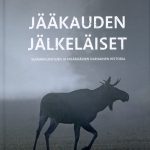For the first time, scientists are putting extinct mammals on the map
-Majid
Dear colleagues,
On behalf of Filipe, I would like to attract your attention on this newly published paper and thank all members of Kurten club for hosting and giving constructive feedback on earlier presentations of this project!
Da Silva, F. O., A.-C. Fabre, Y. Savriama, J. Ollonen, K. Mahlow, A. Herrel, J. Müller, and N. Di-Poï. 2018. The ecological origins of snakes as revealed by skull evolution. Nature communications 9:376.
doi:10.1038/s41467-017-02788-3
Best wishes,
Yoland S.
Reconciling taxon senescence with the Red Queen’s hypothesis (Zliobaite, Fortelius, Stenseth)
https://www.nature.com/articles/nature24656
About it:
https://natureecoevocommunity.nature.com/channels/521-behind-the-paper/posts/25646-do-species-age
https://www.nature.com/articles/d41586-017-07440-0
Productivity, biodiversity, and pathogens influence the global hunter-gatherer population density (Tallavaara, Eronen, Luoto)
http://www.pnas.org/content/early/2017/12/26/1715638115.abstract
Press release in English:
Press release in Finnish:
The rise and fall of the Old World savannah fauna and the origins of the African savannah biome (Kaya, Bibi, Zliobaite, Eronen, Tang, Fortelius)
(Access unfortunately not provided by our university):
https://www.nature.com/articles/s41559-017-0414-1?WT.feed_name=subjects_evolution
About it:
Pirkko Ukkonen ja Kristiina Mannermaa
JÄÄKAUDEN JÄLKELÄISET
Suomen lintujen ja nisäkkäiden varhainen historia
Museovirasto 2017, 240 s.

“Museoviraston uunituore Jääkauden jälkeläiset -julkaisu on kertomus Suomessa jääkauden aikana eläneistä eläimistä, niiden väistymisestä ilmaston muuttuessa ja nykyisten lintu- ja nisäkäslajien saapumisesta maahan sen vapautuessa lopullisesti jäästä ja jäätikön sulavesistä. Yleistajuinen kirja on suunnattu kaikille muinaisuudesta kiinnostuneille lukijoille, mutta se toimii myös tietolähteenä, oppikirjana ja hakuteoksena tutkijoille, opettajille, opiskelijoille ja medialle.”
Dear all,
Janina Rannikko will give the geoscience seminar this Friday (abstract below):
Title: C4-SPECIALIST FOSSIL PIGS AND A MECHANICAL HORSE – RESEARCHING TEETH, DIETS AND ENVIRONMENT IN THE CONTEXT OF PALAEONTOLOGY
Time: Friday 27.1. at 14.15
Location: D114, Physicum, Kumpula campus
***
Abstract:
My PhD research is mainly focused on East African suids (pigs) in Plio-Pleistocene. During 8 million years there has been interesting shifts in the faunal and environmental records of Turkana Basin area. The other part of my work has been fundamental research of dental wear, which has been conducted with the chewing machine built here in Helsinki University.
***
All are welcome!
Anu
http://phys.org/news/2016-12-mammals-age-dinosaurs-powerful.html
From Greg Wilson and colleagues
A large carnivorous mammal from the Late Cretaceous and the North American origin of marsupials. Gregory P. Wilson, Eric G. Ekdale, John W. Hoganson, Jonathan J. Calede & Abby Vander Linden. Nature Communications. DOI: 10.1038/ncomms13734
-Jacqueline
Hi All,
Laura Säilä-Corfe will give the geoscience seminar this week (abstract below):
Title: AROUND THE WORLD IN 129 DOGS: A NEW GLOBAL FOSSIL CANID PHYLOGENY AND THE HISTORICAL PHYLOBIOGEOGRAPHY OF CANINAE
Time: Friday 18.11. at 14.15
Place: D114, Physicum, Kumpula campus
See the upcoming Geoscience seminars in https://wiki.helsinki.fi/display/geoseminar/Geoscience+Seminar
All are welcome!
Anu
***
Abstract
The phylogenetic relationships of North American fossil Canidae have been subject to many recent studies but canids from other continents have received less attention. I present the results of the first ever combined evidence analysis (molecular and morphological characters) of global Canidae, with additional fossil taxa included a-priori based on expert opinion. Our analysis, using Beast 2.3.2 and the R package BEASTmasteR, includes 222 Canidae species (64 in subfamily Borophaginae, 29 in subfamily Hesperocyoninae, and 129 in subfamily Caninae). We also conducted a historical biogeographical analysis of subfamily Caninae using our tip-dated phylogeny, and distribution data from fossil databases (NOW and PBDB). Models that include “founder-event speciation” (speciation coincident with dispersal to a new region) appear to dominate, gaining over 99% of the AIC model weight. Newly developed BioGeoBEARS features will also allow us to estimate whether an absence of a fossil taxon from a certain region is a ‘true absence’ or just ‘absence of evidence’ based on the completeness of the fossil record, resulting in more robust biogeographical models.
Hi all,
our PNAS paper has been published:
Herbivore teeth predict climatic limits in Kenyan ecosystems
http://www.pnas.org/content/early/2016/10/18/1609409113
And the slides from my talk are online here https://sites.google.com/site/zliobaitefiles2/Kurten_ecometrics.pdf
Indrė
Dear All,
The Geoscience seminar this week (Friday 22nd) will be given by professor Mikael Fortelius. Mikael will talk about his recent research from Turkana Basin (abstract below).
Friday 22.4.
Time: 14.15
Location: D114, Physicum, Kumpula Campus
Title: AN ECOMETRIC ANALYSIS OF THE FOSSIL MAMMAL RECORD OF THE TURKANA BASIN
All are most welcome!
***
Abstract
Although ecometric methods have been used to analyse fossil mammal faunas and environments of Eurasia and North America, such methods have not yet been applied to the rich fossil mammal record of East Africa. Here we report results from analysis of a combined dataset spanning east and west Turkana from Kenya between 7 and 1 million years ago. We provide temporally and spatially resolved estimates of temperature and precipitation and discuss their relationship to patterns of faunal change and propose a new hypothesis to explain the lack of a temperature trend. We suggest that the regionally arid Turkana Basin may between 4 and 2 million years ago have acted as a ‘Species Factory’, generating ecological adaptations in advance of the global trend. We show a persistent difference between the eastern and western sides of the Turkana Basin and suggest that the wetlands of the shallow eastern side could have provided additional humidity to the terrestrial ecosystems. Pending further research, a transient episode of faunal change centred at the time of the KBS member (1.87-1.53 million years ago) may be equally plausibly attributed to climate change or to a top-down ecological cascade initiated by the entry of technologically sophisticated humans.